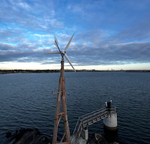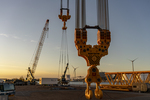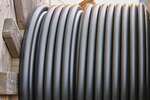10/02/2011
This Week: Can offshore wind turbines provide new biotopes for marine life?
It follows years of uncertainty over the effect construction and operation could have on sea species and seabird sanctuaries, where noise and disturbance from construction and operation were believed to have a negative impact. But research by the Institute for Marine Resources and Ecosystem Studies found that offshore wind farms could act as a new type of habitat for species.
Professor Han Lindeboom said studies on a wind farm off the Dutch North Sea coast showed fish communities were highly dynamic around wind turbines. “Only minor effects upon fish assemblages, especially near the monopiles, have been observed. Some fish species, such as cod, seem to find shelter inside the farm,” he said. “The new hard substratum and the scouring protection led to the establishment of new species and new fauna communities.
“The wind farm acts as a new type of habitat with a higher biodiversity of benthic organisms, a possibly increased use of the area by fish, marine mammals and some bird species, and a decreased use by several other bird species.” Kent has two offshore wind farms, one off the coast of Thanet comprising of 100 turbines – currently the biggest in the world – and the Kentish Flats, a 30-turbine farm off the coast of Herne Bay.
Construction is currently underway on the London Array in the Outer Thames Estuary, which will boast 341 turbines when completed in 2012, becoming the world’s biggest and generating enough electricity for 480,000 homes in Kent. Previous research carried out on the impacts of the farms on marine life had suggested that intense noise caused by pile-driving – the method used to create the foundations of the wind turbines – had a negative effect on sea species.
A report by the Centre for Environment, Fisheries and Aquaculture Science for offshore wind energy company Cowrie, said behaviour of some fish species was seen to alter due to the introduction of wind farms into their habitat. Other studies revealed concerns over changes to feeding patterns as the turbines became artificial reefs and changes to prey occurred, and potential stress caused to sea mammals, such as seals, from changes in noise and vibrations.
The Marine Conservation Society said that although it supported offshore wind energy, developments must be sensitively located. A spokesman said: “Offshore wind power can cause damage to habitats and disturb or displace wildlife during installation and operation. “Developments must therefore be sensitively located, where their potential impacts on marine life, natural physical processes, seascape and other users of the sea are minimised from the outset.”
Professor Han Lindeboom said studies on a wind farm off the Dutch North Sea coast showed fish communities were highly dynamic around wind turbines. “Only minor effects upon fish assemblages, especially near the monopiles, have been observed. Some fish species, such as cod, seem to find shelter inside the farm,” he said. “The new hard substratum and the scouring protection led to the establishment of new species and new fauna communities.
“The wind farm acts as a new type of habitat with a higher biodiversity of benthic organisms, a possibly increased use of the area by fish, marine mammals and some bird species, and a decreased use by several other bird species.” Kent has two offshore wind farms, one off the coast of Thanet comprising of 100 turbines – currently the biggest in the world – and the Kentish Flats, a 30-turbine farm off the coast of Herne Bay.
Construction is currently underway on the London Array in the Outer Thames Estuary, which will boast 341 turbines when completed in 2012, becoming the world’s biggest and generating enough electricity for 480,000 homes in Kent. Previous research carried out on the impacts of the farms on marine life had suggested that intense noise caused by pile-driving – the method used to create the foundations of the wind turbines – had a negative effect on sea species.
A report by the Centre for Environment, Fisheries and Aquaculture Science for offshore wind energy company Cowrie, said behaviour of some fish species was seen to alter due to the introduction of wind farms into their habitat. Other studies revealed concerns over changes to feeding patterns as the turbines became artificial reefs and changes to prey occurred, and potential stress caused to sea mammals, such as seals, from changes in noise and vibrations.
The Marine Conservation Society said that although it supported offshore wind energy, developments must be sensitively located. A spokesman said: “Offshore wind power can cause damage to habitats and disturb or displace wildlife during installation and operation. “Developments must therefore be sensitively located, where their potential impacts on marine life, natural physical processes, seascape and other users of the sea are minimised from the outset.”
- Source:
- Centre for Environment, Fisheries and Aquaculture Science for offshore wind energy
- Author:
- Posted by Trevor Sievert, Online Editorial Journalist / Marijke Cox
- Email:
- ts@windfair.net
- Link:
- www.windfair.net/...
- Keywords:
- wind, wind energy, wind turbine, rotorblade, awea, ewea, wind power, suppliers, manufacturerstrevor sievert






